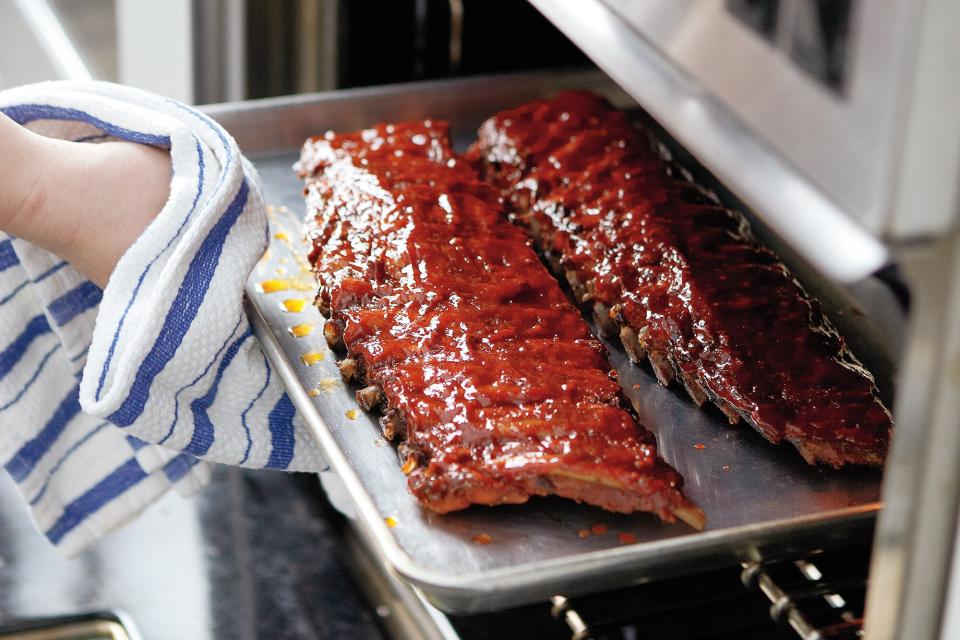How to Use Your Oven's Broiler for Perfect, Crispy Results Every Time
TABLE OF CONTENTS
On This Page
Broiler 101
Best Foods to Broil
Best Cookware for Broiling
Broiling Tips
Do you love your broiler? You should! It's the ticket to fast, flavorful meals. Similar to grilling, broiling uses high, direct heat to cook food quickly and give it a tasty, browned crust. In fact, broiling can even impart professional-level results.
"High heat is the chef's key to creating delicious, restaurant-quality flavor," says Joel Chesebro, head demonstration chef at Sub-Zero, Wolf, and Cove. "Using a broiler gives you that same capability in your home kitchen." If that's not enough of an incentive, consider this: Broiling is a cooking method that you can rely on 24/7, rain or shine, in snowstorms or in heatwaves. Better yet, broilers are a good substitute if you can't fire up the grill in the backyard. If your broiler doesn't see much action, follow our tips—we think it will become your new favorite way to cook.
Related: Try These Stir Fry Recipes for a Fast Way to Make Dinner

Ned and Aya Rosen
Get to Know Your Broiler
The broiler's heating element is usually located at the top of the oven. If it's not there, then there is generally a separate broiler compartment underneath the oven.
Unlike ovens, broilers often have only two settings: "on" and "off" (occasionally, these settings appear as "high" and "low"). Different broilers heat to different temperatures, and gas models tend to run hotter than electric. The distance between the rack and the heating element, coupled with a few tricks of the trade, also affects how fast food will cook. "You can control the broiler intensity by lowering the rack position, which allows for intense top-down heat without overcooking or burning your food," says Chesebro.
Watch the Broiler Carefully
Given a broiler's powerful heat, you need to take recipe cooking times with a grain of salt. Instead of setting a timer, stand by, and be ready to reposition racks if needed. "When broiling, it's important to stick around in front of the oven and continue to monitor the food so it doesn't burn or worse, catch on fire (with very greasy foods)," says the R&D team at LG Electronics USA. "Also, broiling is like grilling, so expect some smoke. Turn on your vent hood to exhaust any smoke out of the kitchen."
Door Open or Shut?
The oven you grew up with may have required that the door be left open a crack while broiling, but don't assume that your modern appliance follows the same rule of thumb. Generally, gas ovens call for closed-door broiling, while electric ovens instruct open-door broiling. It all comes down to your specific range, so reference the owner's manual for instructions.
Foods You Should Broil
Thin-Cut Foods
As a general rule, broil thin foods: Steaks, pork chops, fish fillets, and chicken cutlets are all broiler-perfect, as are shrimp and tofu. So, why thin? If cuts are too thick, they may scorch before cooking through.
Dishes That Need a Golden Finish
Since the intense heat source is above the food (not under it, as with a grill) you can use the broiler to get a crispy golden-brown topping on a casserole or gratin or to finish off the top of a pizza—or any surface that needs extra color. "I love using the broiler to precisely melt and brown cheese, or provide delicious texture and flavor to vegetables," says Chesebro.
Multi-Step Meals
The broiler is also a wonderful resource for a multi-step cooking process. "For instance, you can bake your lasagna using convection and then add cheese and broil to perfection," says Chesebro.
Toasted Breads
If you're short on countertop space, he suggests eliminating your toaster oven and turning to the broiler to toast English muffins, toast, bagels, and more.
Fruit Desserts
And next time you want a quick dessert? Turn to the broiler. It does an ace job with fruit—try broiled pineapple or bananas.
Best Cookware to Use for Broiling
A broiler pan—a rectangular pan with slats for air circulation—typically comes with a new stove. If you've lost track of yours, no worries; there are some worthy substitutes, like a cast-iron skillet or griddle, that are heat-safe up to 550 degrees.
Another option: a heavy-duty baking sheet, which won't warp under the heat. "Make sure these have some lip around the edge to prevent any grease from dripping over. Even a metal wire cooling rack on top of a roasting pan (to catch drippings) can be used, too," says the R&D Team at LG Electronics.
What Not to Use When Broiling
Never use glass, nonstick, or enameled cookware under the broiler—and always check that your hot pads are dry.
How to Broil Foods Successfully
In addition to keeping an eye on food while it broils, follow these steps for broiler success:
Be sure to preheat the broiler for at least five minutes, so the food gets a blast of heat when it goes in. Preheating the pan is also a must to obtain a really good sear on foods like steak. If you opt for thicker cuts of meat, preheat a cast-iron griddle under the broiler before placing your steak on it; flip it when the first side reaches the desired searing, says the LG Electronics team.
Bring all food to room temperature before broiling, as this helps promote more even cooking. Pat food dry, removing marinade or moisture, before cooking.
After broiling and as soon as the broiler compartment has cooled down enough, wipe it out with a damp cloth to remove any spatters. That way, you won't let the mess build up—and you'll be ready for your next broiler dinner.

